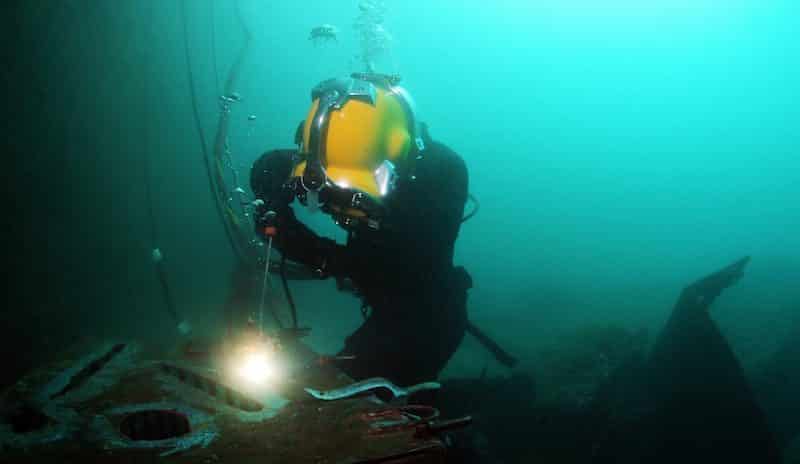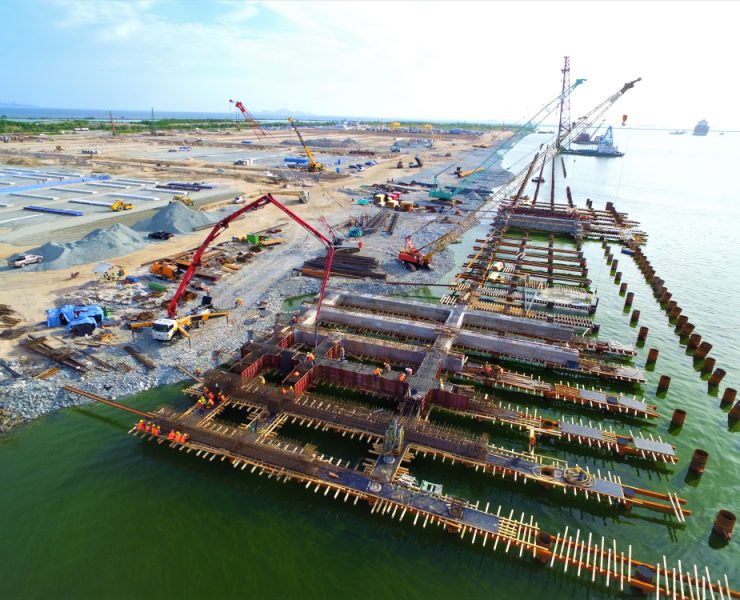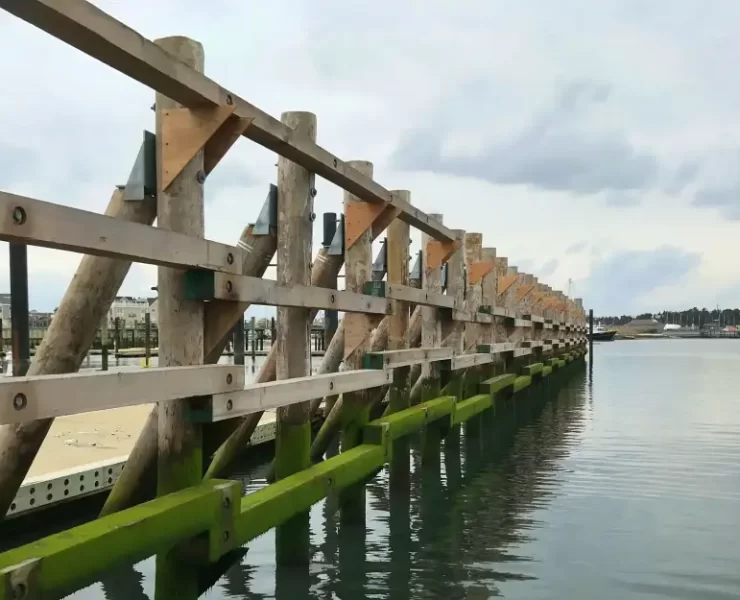Underwater Welding Procedures And Safety

BASIC TECHNIQUES
For successful wet-welding, whether you are an experienced or novice welder, the first thing you have to accept is the range of personal skills which may be used for surface welding, do not exist for underwater. Often when I speak to divers, I am asked if as a non-welder I can teach someone to weld to a satisfactory standard in two weeks. Well, barring any lack of basic co-ordination skills, the answer is yes.
Having trained well over a thousand divers over the years, with the odd exception, it would be expected that a non-welder could achieve multipass fillet weldments in at least the horizontal-vertical and vertical down positions within this time frame. Of greater surprise, is my usual reply to experienced surface welders. “Well it will depend up on whether you can disassociate yourself from accepted surface welding practice, quickly enough”. “No problem” is the usual response. However, I have yet to meet the surface welder who can simply turn his hand to wet-welding techniques without some short term difficulties.
You see for an experienced surface welder, the range of skills and manipulative techniques he understands will work on surface, given a particular circumstance, offer little help underwater. He must except that the range of personal skill and talent he has for surface welding, in the early stages of training, will do him no good at all when it comes to wet welding. This is because the basic techniques of wet welding are in fact, very simple. There is simply no need for anything clever in producing a good underwater wet-weld. Simple is best.
The three basic techniques I teach for underwater wet-stick welding are as follows:
1. Drag or self-consuming technique.
2. Oscillation technique.
3. Step-back technique.
All these are touch techniques. This is the basic principle of all underwater wet welding. Of course, as you become very much more competent you can and will start to deviate to styles of your own. It is true to say that touch techniques are not the only way in which wet welding can take place, but certainly at the basic/standard level, they are the only techniques required.
With the drag technique, the electrode is simply dragged across the work and the diver only has to apply a slight downward pressure, whilst the electrode is being consumed. Providing he maintains the appropriate lead and slope angle, together with a suitable travel speed, the electrode will produce a regular bead of suitable profile, almost on its own. Perhaps it doesn’t sound that simple after all, with all those different things to master. Well it’s certainly not a difficult technique.
Perhaps the most difficult thing most trainees find hard to master in the early stages isn’t so much the appropriate lead/ slope angles, or the correct travel speed or even maintaining a touch technique. By far the most common factor that causes most headaches is establishing the correct current. Because it’s true to say, that no matter how well you attempt to control the above, without a suitable current, you are on a ‘sticky wicket’ (no win) and it can take you some time to recognise the correct current values.
To allow for minor changes in travel speed, changing the lead angle is required. In general, the steeper the lead angle, the slower the rate of travel and the wider the weld bead and deeper the penetration. For underwater wet welding a shallower lead angle than that used for surface welding is required, of between 35–45º. This is to allow for the bubbles to escape without unduly interfering with the weld puddle.
Another very important angle is the slope angle. This is used to enable accurate weld deposition within the joint. It must be understood that when using touch techniques the slope angle is the only mechanism that can be used to deposit weld metal in a particular location, and therefore, the use of slope angle control is vital.
The drag technique will be used initially by the novice.This will allow for a period of adjustment, as the information provided by the arc is somewhat confusing and in practice a constant contact technique is easier to maintain and will result in repeatable performance, allowing for greater control of quality.
As with all welding techniques however, there is a careful balance to address between all the senses, i.e. sight, sound and touch. This technique in particular is best used on the second pass of a multipass fillet weld, as usually, just a straightforward stringer bead is all that’s required. For butt welds too, the drag technique is very well suited. Welding position has very little effect upon this particular technique (see welding exercise sheet for more guidance on all techniques).When welding is done using the drag technique, the weld metal is deposited in a series of beads or stringers, by dragging the electrode along the work. This technique is suited to both fillet and butt welds.
I have used this word for so long, I should perhaps advise you that it’s not strictly speaking, a correct term/definition used for manual welding. However, I use it because then there’s no misunderstanding between this and the better known term ‘weaving’. I don’t use the term weave because it’s meaning is inaccurate. Underwater when using touch techniques, weaving isn’t used, although quite possible, isn’t needed.
Right, now we have sorted that out, let’s look at what we do.With the oscillation technique the electrode is oscillated so that the point closest to the holder, and not the end closest to the work, is raised and lowered in a vertical direction, i.e. the slope angle is constantly changed whilst welding. This aids metal deposition and prevents non-concentric burning of the electrode, especially when welding in the root of a joint.
Concentric burning may be described as a uniform melting of the electrode, around it’s entire circumference. Due to the slightly lower lead angles required for wet welding, and the fact that touch techniques are used, the electrode makes contact with only a small surface area. This sooner or later results in the part closest to the workpiece burning a little faster than its opposite face. The result is non-uniform melting of the electrode, and the arc deflects to the point closest to the work. At this stage, it’s simply not possible to control the metal deposition or even see the arc properly. It may in certain circumstances be corrected by simply twisting your wrist, thereby, allowing the opposite side of the electrode to come into contact with the work piece, allowing the flux covering to catch up.
This particular technique is best used for the root run in fillet welded joints, because this is when the electrode is most likely to misbehave.
3. STEP-BACK
Again, this word is not a term given in BS 499-1: 1991 welding terms and symbols. However, I use it because it does describe the technique accurately. This technique involves stalling the forward travel speed for a second and then travelling backwards, into the weld pool for a few millimetres. This technique aids improvements to throat thickness and weld width, together with some improvements in the control of the solidification/cooling rate of the weld puddle. Both of these techniques however, demand a little more skill and experience on behalf of the diver, together with an understanding of the solidification pattern of the weld and its effects upon the material. Suffice to say, it’s a little more difficult due to the greater degree of control required.
For fillet welds at least, this technique is very well suited for the last pass, of a three pass weld. This is because it will mop up any little mistakes caused by inaccurate weld placement of the second pass and allow in tidying the whole weld up. Accurate weld placement, no matter which technique is used, is another wet-welding difficulty that the trainee can expect.
If you take a quick look now at the exercise sheets, you will see that slope angle is the mechanism that controls just where the weld gets deposited. I am sure it won’t surprise you to learn that it doesn’t take much to make a complete hash of this. Fillet welds are without doubt the most common joint type used for wet welding and this book deals predominately with them. However, butt welds can be accomplished just as successfully, although they aren’t required anything like those of fillet welds.
In the welding metallurgy chapter you will see various weldments, both fillet and butt welds that have been completed successfully. As previously mentioned with underwater wetwelding electrodes, the flux covering extends beyond the end of the core wire, this helps prevent the end of the electrode from welding itself or sticking to the work and permits for an acceptable transfer of molten metal across the arc gap. It should also be remembered that lead and slope angles, together with travel speed, are far more critical in underwater welding than surface welding, due to the visibility and environmental conditions, and as such, will take a little time for you to master.
DAVID KEATS
David Keats is the MD of Specialty Welds Ltd, a company specializing in underwater welder training, consultancy and welding inspection services. Specialty Welds is a UK-based company and David has been in the world of welding for over 39 years. David has published two books of underwater welding and offers the Weldcraft-Pro welding course to other training providers as well as commercial companies. For more information about David and his company, please visit //www.specialwelds.com.
APPENDIX D: SAFETY IN UNDERWATER CUTTING AND WELDING
D-1 PURPOSE
This appendix is intended to cover safety precautions to be followed while preparing for and conducting underwater cutting or welding operations. All personnel should read and comprehend the safety precautions listed in this section and the safety summary contained in the front section of this manual. Deviation from established standards are of course potentially dangerous; however, the most serious aspect of disregarding safety rules may not be the initial deviation, but the tendency to treat other rules just as casually.Remember, safety is a full-time job and the more safetyconscious each team member becomes, the safer each diving operation becomes.
For detailed information on chemical hazards encountered in salvage, refer to the U.S. Navy Ship Salvage Safety Manual, (S0400-AA-SAF-010), which covers toxic, explosive, corrosive and other special nature perils.
D-2 GENERAL
Underwater cutting and welding operations involve several hazards, including lethal electrical currents, oxygen and hydrogen rich gases which will explode in the presence of a spark and electrode tip temperatures in excess of 10,000°F. It is impossible to anticipate all possible situations that may arise in underwater cutting or welding operations. Consequently, it can not be assumed that safe operating conditions will exist simply by blindly following the guidelines set forth in this manual. Nonetheless, with a thorough knowledge of cutting and welding fundamentals combined with the use of common sense and sound judgment, the procedures described in this manual can be performed in maximum safety.
D-3 EXPLOSIVE GASES
WARNING: Do NOT attempt to speed up the cutting by creating a fire or inferno deep inside the metal. Such a situation can lead to an explosion.
WARNING: A diver is at risk to severe electrical shock when performing a cutting or welding operation while only partially immersed in water. Hence, the splash zone is the most hazardous location in which a diver can be placed.
WARNING: NEVER bring a cutting torch into a bell with the oxygen on or with the welding generator running.
D-3.1 General Information. Gases produced by underwater cutting are rich in oxygen and hydrogen and will explode if trapped and ignited. Gases from underwater cutting will collect in closed compartments, open tubular structural members, open piping systems, shaped structural members and under such members as “H” beams. Before cutting, it is mandatory that provision be made to evacuate existing gases and eliminate the possibility of further gas entrapment.Refer to Naval Ships Technical Manual NAVSEA S9086-CHSTM- 030/CH-074 Volume 3 for detailed information on gas-free engineering.
If the presence of trapped explosive gas mixtures is uncertain, it may be necessary to drill holes in suitable locations to allow the gases to escape. This will flood the compartment with sea water. An alternative would be to purge the compartment with a mixture of gases which will not support combustion.
D-3.2 Specific Information. Underwater cutting and welding processes generate explosive gases.
. When cutting with power on or welding, hydrogen and oxygen are dissociated from the water and will travel separately as bubbles. These bubbles can collect in a trapped or confined space overhead. As the hydrogen and oxygen gases combine they will ignite, causing a popping sound.
. Oxygen cutting is about 60 percent efficient, resulting in approximately 40 percent pure oxygen being released into the environment. This gas can become entrapped above the work area, and when combined with a fuel such as hydrocarbons, can easily be ignited by a hydrogen bubble or a spark trapped in the bubble.
Any pop is a sign of explosive gases collecting above the underwater work area and is the point when cutting or welding must stop and the cause investigated.
Prior to the start of any underwater cutting or welding, as built drawings and physical configuration of the work area must be studied to determine all these areas and voids that could contain or trap explosive gases. These areas and voids must be vented or made inert in accordance with Naval Ships Technical Manual NAVSEA 59086-CH-STM-030/CH-074 Vol 3 to prevent possible explosions.
Care should also be taken when cutting or welding on enclosures that are on or above river beds, especially in mud, because trapped methane gas in the proper concentrations can explode.
Explosive gases may be produced by any one or a combination of the following:
. Petroleum products such as gasoline, fuel oil or greases;
. Paint mixing mediums, such as linseed oil or thinners;
. Epoxies, adhesives and solvents;
. Ammunition or bulk explosives;
. Decaying vegetable or animal matter; and
. Unburned gases from cutting torches.
Every precaution must be taken to prevent an underwater explosion. To minimize the possibility of explosions from trapped gasses, the following procedures are recommended:
a. Start cutting at the highest point and work downward.
B. When cutting thick material, i.e., propeller shafting, cut from the outside and work around the circumference. By withdrawing the electrode every few seconds to allow water to enter the cut, exceedingly high temperatures can not build up inside the metal. A brushing or stroking action in the direction of the intended cut should be used.
C. Gases may be vented to the surface with a vent tube (flexible hose) secured in place from the high point where gases would collect to a position above the waterline.
D. When working under a sea chest, gas can be vented by briefly opening an internal valve or by the above method.
WARNING: AC power shall not be used for underwater cutting or welding due to the extreme danger involved with AC current underwater.
Electrical shock produced by AC current prevents voluntary relaxation of the muscles controlling the hand. Consequently, the diver may be unable to let go if his body or equipment accidentally enters the electrical circuit.
Electricity and water are incompatible by nature and the use of electrically powered equipment underwater presents a potential shock danger to both the diver and the tender.When using electrically powered equipment such as cutting, welding or underwater lighting, the diver and tender must be protected from electric shock. All personnel engaged in underwater cutting and welding should be thoroughly trained in CPR and first-aid so they can render immediate assistance in the event of an accident.
The results of a study conducted for the Navy revealed that the principal underwater electrical hazard facing divers engaged in welding and cutting is non-lethal electric shock. The hazard exists when a diver wearing inadequate protective dress is in close proximity to a relatively highpowered source of electricity. AC power was found to pose a considerably greater threat to the diver than DC, therefore AC power will NOT be used for underwater cutting or welding.
Electrical current above shock levels that passes through human tissue is known to temporarily alter the physiological function of cells. The long-term effects, if any, are unknown.Much greater levels can cause thermal burns. Severe shocks could conceivably result in respiratory or cardiac arrest in divers. In addition, minor shocks may cause loss of control, panic or injury due to involuntary muscle contraction. Therefore, with the exception of a tingle at arc initiation, unpleasant electric shocks should not be tolerated in underwater operations, even though no physiological damage may be immediately apparent.
The safety rules listed in the following sections must be followed to provide maximum personal safety for the diver.
D-5 GENERAL PRECAUTIONS FOR UNDERWATER CUTTING AND WELDING
There are many conditions which contribute to making underwater work difficult. These include adverse currents, unstable footing, poor visibility and low temperatures. A constant source of danger comes from the falling or rolling of cut-away pieces. This is especially true in salvage wrecking. These, combined with the dangers involved in operating an electric arc capable of producing fatal shock, severe burns and explosive gas pockets, create a situation where the diver must be extremely alert. The following precautions must be observed:
a. Careful examination should be made before starting the cut to learn how the cut-away pieces will fall and whether there are any projections, wires or other objects which may foul lines or cause a piece to swing around in an unexpected manner.
B. Be extremely careful when cutting tightly-bound wire rope, e.g., wire wrapped in a ship’s propeller. When severed, the wire can back-lash with spring-like force.
C. Before cutting, ensure that umbilical and diving equipment will not be in the path of slag from the cutting operation.
D. Avoid cutting overhead if possible, since the falling molten material will seriously damage the diving helmet, dress and umbilical.
E. Never put down or carry an electrode holder while the power is on.
F. Never change an electrode while the power is on.
G. The diver must never allow any body part or equipment to come in contact with the grounded work when the safety switch is closed.
H. Care should be taken with diver-carried large loose metallic items (i.e., wrenches and backpacks) to ensure no contact is made with a live electrode or the work.
What are the basic techniques for underwater wet welding, and which one is recommended for novices?
The basic techniques for underwater wet welding are the Drag or self-consuming technique, Oscillation technique, and Step-back technique; for novices, the Drag technique is often recommended as it is easier to maintain.
Why is AC power not used for underwater cutting or welding, and what is the primary electrical hazard facing divers in welding and cutting operations?
AC power is not used underwater due to the extreme danger involved with AC current; the primary electrical hazard facing divers in welding and cutting operations is non-lethal electric shock, with AC power posing a considerably greater threat than DC.

















